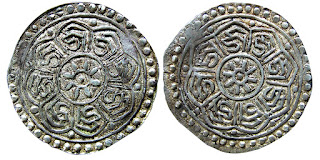It has taken me years of research to untangle the web of confusion surrounding our coinages - but I am now almost nearing the end of the road. I believe that I have more or less managed to bring some semblance of order in how and when and where our coinage began.
In my continuous and extended intercourse with coin historians and writers across the globe, some new information have surfaced – also some existing ones had to be dismantled and corrected. That is of course natural – after all, history has always been subject to revision and rewriting. But something intrigued me – something to which I had not given any thoughts earlier:
The fact that there is no mention anywhere – whether the Tibetan Lama Ngawang Namgyal brought any silver Tangkas with him, when he entered Bhutan in 1616.
The above question became pertinent to me – during my quest to decide what to call our ancient hammered coins – the origin of the word.
We know for a fact that Tibet’s earliest silver coin – the silver Vartula Tangka - was hammered in Tibet sometime in 1743/1744. Before that, they were supposedly using silver Tangkas of Nepal. But one of the coin historians writes to me to tell me that “Nepali silver coins circulated in Tibet long before 1640”.
But the question is: How long before?
Tibet's first homegrown Silver Vartula Tangka hammered in 1743
Or, may be, he did bring. Do any readers know?
During the Tibetan exodus of the early 1950s, sack loads of silver Boetangs, Baltangs, Chinese Dayang/Gormo and British India silver Rupees were brought into the country by the fleeing Tibetans – so much so that hundreds and thousands of them are still available in the country.
History has a habit of throwing up strange and most unlikely facts!


No comments:
Post a Comment